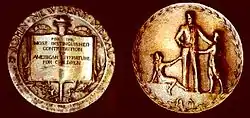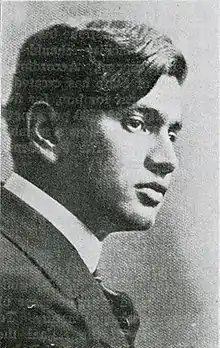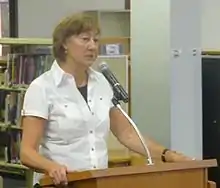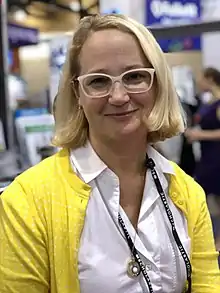Newbery Medal
The John Newbery Medal, frequently shortened to the Newbery, is a literary award given by the Association for Library Service to Children (ALSC), a division of the American Library Association (ALA), to the author of "the most distinguished contribution to American literature for children".[1] The Newbery and the Caldecott Medal are considered the two most prestigious awards for children's literature in the United States.[2] Books selected are widely carried by bookstores and libraries, the authors are interviewed on television, and master's and doctoral theses are written on them.[3] Named for John Newbery, an 18th-century English publisher of juvenile books, the winner of the Newbery is selected at the ALA's Midwinter Conference by a fifteen-person committee. The Newbery was proposed by Frederic G. Melcher in 1921, making it the first children's book award in the world.[3][4]:1 The physical bronze medal was designed by Rene Paul Chambellan and is given to the winning author at the next ALA annual conference. Since its founding there have been several changes to the composition of the selection committee, while the physical medal remains the same.
| Newbery Medal | |
|---|---|
 | |
| Awarded for | "The most distinguished contribution to American literature for children" |
| Country | United States |
| Presented by | Association for Library Service to Children, a division of the American Library Association |
| First awarded | 1922 |
| Currently held by | Tae Keller, When You Trap a Tiger |
| Website | ala |
Besides the Newbery Medal, the committee awards a variable number of citations to leading contenders, called Newbery Honors or Newbery Honor Books; until 1971, these books were called runners-up. As few as zero and as many as eight have been named, but from 1938 the number of Honors or runners-up has been one to five. To be eligible, a book must be written by a United States citizen or resident and must be published first or simultaneously in the United States in English during the preceding year.[5] Six authors have won two Newbery Medals each, several have won both a Medal and Honor, while a larger number of authors have won multiple Honors, with Laura Ingalls Wilder having won five Honors without ever winning the Medal.
History

The Newbery Medal was established on June 22, 1921, at the annual conference of the American Library Association (ALA).[6] Proposed by Publishers Weekly editor Frederick Melcher, the proposal was well received by the children's librarians present and then approved by the ALA Executive Board.[7] The award was administered by the ALA from the start, but Melcher provided funds that paid for the design and production of the medal.[8]:59 The Newbery Medal was inaugurated in 1922, considering books published in 1921.[9]:1[lower-alpha 1] According to The Newbery and Caldecott Awards Melcher and the ALA Board agreed to establish the award for several reasons that related to children's librarians. They wanted to encourage quality, creative children's books and to demonstrate to the public that children's books deserve recognition and praise.[4]:1 In 1932 the committee felt it was important to encourage new writers in the field, so a rule was made that an author would win a second Newbery only if the vote was unanimous.The rule was in place until 1958.[4]:2 Joseph Krumgold became the first winner of a second Newbery in 1960. Another change, in 1963, made it clear that joint authors of a book were eligible for the award.[4]:2 Several more revisions and clarifications were added in the 1970s and 1980s.[4]:2–3 Significantly in 1971, the term Newbery Honor was introduced. Runners-up had been identified annually from the start, with a few exceptions only during the 1920s; all those runners-up were named Newbery Honor Books retroactively.[4]:2[7]
Medal
The physical medal was designed by Rene Paul Chambellan and depicts an author giving his work (a book) to a boy and a girl to read on one side and on the other side the inscription, "For the most distinguished contribution to American literature for children".[4]:3, 8 The bronze medal retains the name "Children's Librarians' Section", the original group responsible for awarding the medal, despite the sponsoring committee having changed names four times and now including both school and public librarians.[4]:3 Each winning illustrator gets their own copy of the medal with their name engraved on it.[6] Currently the Association for Library Service to Children (ALSC) is responsible for the award.[1]
Committee
.jpg.webp)
As Barbara Elleman explained in The Newbery and Caldecott Awards, the original Newbery was based on votes by a selected jury of Children's Librarian Section officers. Books were first nominated by any librarian, then the jury voted for one favorite. Hendrik van Loon's non-fiction history book The Story of Mankind won with 163 votes out of 212.[11]:11 In 1924 the process was changed, and instead of using popular vote it was decided that a special award committee would be formed to select the winner. The award committee was made up of the Children's Librarian Section executive board, their book evaluation committee and three members at large. In 1929 it was changed again to the four officers, the chairs of the standing committees and the ex-president. Nominations were still taken from members at large.[11]:13
In 1937 the American Library Association added the Caldecott Award, for "the artist of the most distinguished American picture book for children published in the United States".[12] That year an award committee selected the Medal and Honor books for both awards.[8]:7 In 1978 the rules were changed and two committees were formed of fifteen people each, one for each award. A new committee is formed every year, with "eight elected, six appointed, and one appointed Chair".[4]:7 The Newbery Medal was named for eighteenth-century British bookseller John Newbery. It is awarded annually by the Association for Library Service to Children, a division of the American Library Association, to the author of the most distinguished contribution to American literature for children.
Selection process
Committee members are chosen to represent a wide variety of libraries, teachers and book reviewers. They read the books on their own time, then meet twice a year for closed discussions. Any book that qualifies is eligible; it does not have to have been nominated. The Newbery is given to the "author of the most distinguished contribution to American literature for children published by an American publisher in the United States in English during the preceeding year."[4] :4 Newbery winners are announced at the Midwinter Meeting of the American Library Association, held in January or February.[9]:8 The Honor Books must be a subset of the runners-up on the final ballot, either the leading runners-up on that ballot or the leaders on one further ballot that excludes the winner.[8]:37 The results of the committee vote are kept secret, and winners are notified by phone shortly before the award is announced.[4]:8 In 2015, K. T. Horning of the University of Wisconsin–Madison's Cooperative Children's Book Center proposed to ALSC that old discussions of the Newbery and Caldecott be made public in the service of researchers and historians.[13] This proposal was met with both support and criticism by former committee members and recognized authors.[14][15]
Criticism
In October 2008, Anita Silvey, a children's literary expert, published an article in the School Library Journal criticizing the committee for choosing books that are too difficult for children.[3][16] Lucy Calkins, of the Reading and Writing Project at Columbia University's Teachers College, agreed with Silvey: "I can't help but believe that thousands, even millions, more children would grow up reading if the Newbery committee aimed to spotlight books that are deep and beautiful and irresistible to kids".[3] But then–ALSC President Pat Scales said, "The criterion has never been popularity. It is about literary quality. How many adults have read all the Pulitzer Prize-winning books and... liked every one?"[3] John Beach, associate professor of literacy education at St. John's University in New York, compared the books that adults choose for children with the books that children choose for themselves and found that in the past 30 years there is only a five percent overlap between the Children's Choice Awards (International Reading Association) and the Notable Children's Books list (American Library Association).[3] He has also stated that "the Newbery has probably done far more to turn kids off to reading than any other book award in children's publishing."[3]
Recipients










.jpg.webp)






Multiple award winners
Listed below are all authors who have won at least two Newbery Medals or who have three or more Medals and/or Honors. Won a Newbery Medal and Honor
.jpg.webp)

| Author | Total number of Medals and Honors | Number of Newbery Medals | Newbery Medals | Number of Newbery Honors | Newbery Honors |
|---|---|---|---|---|---|
| Avi | 3 | 1 | 2003 | 2 | 1991, 1992 |
| Mary & Conrad Buff | 3 | 3 | 1947, 1952, 1954 | ||
| Beverly Cleary | 3 | 1 | 1984 | 2 | 1978, 1982 |
| Padraic Colum | 3 | 3 | 1922, 1926, 1934 | ||
| Christopher Paul Curtis | 3 | 1 | 2000 | 2 | 1996, 2008 |
| Alice Dalgliesh | 3 | 3 | 1945, 1953, 1955 | ||
| Meindert DeJong | 5 | 1 | 1955 | 4 | 1954, 1954, 1957, 1959 |
| Kate DiCamillo | 3 | 2 | 2004, 2014 | 1 | 2001 |
| Jeanette Eaton | 4 | 4 | 1930, 1934, 1945, 1951 | ||
| Eleanor Estes | 4 | 1 | 1952 | 3 | 1943, 1944, 1945 |
| Nancy Farmer | 3 | 3 | 1995, 1997, 2003 | ||
| Genevieve Foster | 4 | 4 | 1942, 1945, 1950, 1953 | ||
| Russell Freedman | 4 | 1 | 1988 | 3 | 1992, 1994, 2005 |
| Elizabeth Janet Gray | 4 | 1 | 1943 | 3 | 1931, 1936, 1939 |
| Virginia Hamilton | 4 | 1 | 1975 | 3 | 1972, 1983, 1989 |
| Marguerite Henry | 3 | 1 | 1949 | 2 | 1946, 1948 |
| Agnes Hewes | 3 | 3 | 1931, 1934, 1937 | ||
| Jennifer L. Holm | 3 | 3 | 2000, 2007, 2011 | ||
| Clara Ingram Judson | 3 | 3 | 1951, 1954, 1957 | ||
| E. L. Konigsburg | 3 | 2 | 1968, 1997 | 1 | 1968 |
| Joseph Krumgold | 2 | 2 | 1954, 1960 | ||
| Lois Lenski | 3 | 1 | 1946 | 2 | 1937, 1942 |
| Lois Lowry | 2 | 2 | 1990, 1994 | ||
| Eloise Jarvis McGraw | 3 | 3 | 1953, 1962, 1997 | ||
| Cornelia Meigs | 4 | 1 | 1934 | 3 | 1922, 1929, 1933 |
| Scott O'Dell | 4 | 1 | 1961 | 3 | 1967, 1968, 1971 |
| Anne Parrish | 3 | 3 | 1925, 1931, 1951 | ||
| Katherine Paterson | 3 | 2 | 1978, 1981 | 1 | 1979 |
| Gary Paulsen | 3 | 3 | 1986, 1988, 1990 | ||
| Kate Seredy | 3 | 1 | 1938 | 2 | 1936, 1940 |
| Isaac Bashevis Singer | 3 | 3 | 1967, 1968, 1969 | ||
| Zilpha Keatley Snyder | 3 | 3 | 1968, 1972, 1973 | ||
| Elizabeth George Speare | 3 | 2 | 1959, 1962 | 1 | 1984 |
| Laura Ingalls Wilder | 5 | 5 | 1938, 1940, 1941, 1942, 1944 | ||
| Jacqueline Woodson | 4 | 4 | 2006, 2008, 2009, 2015 |
See also
- Carnegie Medal for a children's or young-adult book published in the UK
- Michael L. Printz Award for a young-adult book published in the US
- Caldecott Medal for illustration of an American children's picture book
- Laura Ingalls Wilder Medal for lifetime contribution to American children's literature
- Hans Christian Andersen Award for lasting contribution to children's literature
- Ebook Central Academic Complete. In the Words of the Winners: The Newbery and Caldecott Medals, 2001-2010. Chicago: American Library Association, 2011.
Notes
- In retrospect it is officially dated 1922 and that convention is followed here.
- Anne and Dillwyn Parrish jointly created The Dream Coach, one of two runners-up in 1925. But the title page of the first edition clearly states (all capitals except 'by'): "By Anne and Dillwyn Parrish * * With Pictures & A Map by The Authors".[lower-alpha 3]
Anne is better known as a writer, Dillwyn as an artist and illustrator, and some sources credit them as writer and illustrator respectively. As of May 2016 the official list of Newbery Medal winners and runners-up cites Anne Parrish alone as the writer.[lower-alpha 4] (It cites no illustrator, and thus does not mention Dillwyn, because the Newbery is a literary award.)
Anne Parrish alone wrote and illustrated Floating Island and The Story of Appleby Capple, Newbery runners-up in 1931 and 1951. Regarding the latter, Delaware book collector John P. Reid notes: "A juvenile, dedicated to her deceased younger brother Dillwyn and based on an alphabet game he and Anne had played as children." Reid briefly reviews their two jointly written and illustrated children's books, as well as Appleby Capple.[lower-alpha 5] - The Dream Coach (title page targeted). New York: The Macmillan Company, 1924. Electronic reproduction. [S.l.]: HathiTrust Digital Library (hdl.handle.net), 2011. OCLC 765763078. Retrieved June 1, 2016.
- "Anne Parrish" Archived March 4, 2016, at the Wayback Machine. John P. Reid. Collecting Delaware Books (jnjreid.com/cdb). Retrieved June 1, 2016.
References
- "Welcome to the Newbery Medal Home Page!" Archived May 4, 2013, at the Wayback Machine. Association for Library Service to Children (ALSC). American Library Association (ALA). Retrieved May 5, 2013.
- Drabble, Emily (January 12, 2016). "Winners of Newbery, Caldecott and Printz awards announced". The Guardian. ISSN 0261-3077. Archived from the original on January 1, 2019. Retrieved December 31, 2018.
- Strauss, Valerie (December 16, 2008). "Critics Say Newbery-Winning Books Are Too Challenging for Young Readers". The Washington Post. p. C01. Archived from the original on December 17, 2008. Retrieved February 24, 2009.
- The Newbery & Caldecott Awards : a guide to the medal and honor books. Association for Library Service to Children, American Library Association (2018 ed.). Chicago. ISBN 9780838917305. OCLC 1020310919.CS1 maint: others (link)
- "Newbery Medal terms and criteria" Archived May 4, 2013, at the Wayback Machine. ALSC. ALA. January 1978; Midwinter 1987; Annual 2008. Retrieved May 4, 2013.
- "The John Newbery Medal". Association for Library Service to Children (ALSC). November 30, 1999. Archived from the original on November 6, 2018. Retrieved December 31, 2018.
- "The John Newbery Medal". ALSC. ALA. November 30, 1999. Archived from the original on August 7, 2011. Retrieved May 23, 2011.
- "John Newbery Medal Committee Manual" (PDF). ALSC. ALA. October 2009. Archived from the original (PDF) on November 10, 2013. Retrieved January 1, 2019.
- The Newbery and Caldecott awards : A Guide to the Medal and Honor Books. Association for Library Service to Children. (2008 ed.). Chicago: American Library Association. 2008. ISBN 9781441619211. OCLC 435528356.CS1 maint: others (link)
- Matthew O Grenby (2013). "Little Goody Two-Shoes and Other Stories: Originally Published by John Newbery". p. 7. Palgrave Macmillan
- The Newbery and Caldecott awards : a guide to the medal and honor books. Association for Library Service to Children. (2007 ed.). Chicago: American Library Association. 2007. ISBN 978-0-8389-3567-5. OCLC 135585274.CS1 maint: others (link)
- "The Randolph Caldecott Medal". ALSC. ALA. November 30, 1999. Archived from the original on October 18, 2016. Retrieved July 30, 2012.
- Horning, Kathleen T. (June 3, 2016). "I Could Tell You About the Newbery and Caldecott Committees. But I Can't. | Up for Debate". School Library Journal. Archived from the original on January 1, 2019. Retrieved December 31, 2018.
- Spicer, Ed (June 3, 2016). "Let Book Awards Committee Members Blab | Up for Debate". School Library Journal. Archived from the original on January 1, 2019. Retrieved December 31, 2018.
- Santat, Dan (June 3, 2016). "Why You Don't Want To Know More About the Newbery and Caldecott | Up for Debate". School Library Journal. Archived from the original on January 1, 2019. Retrieved December 31, 2018.
- Silvey, Anita (October 1, 2008). "Has the Newbery Lost Its Way?". School Library Journal. Retrieved January 4, 2017.
- Gandhi, Lakshmi (June 17, 2017). "Remembering the first Indian-American children's book to win a Newbery". NBC News. Archived from the original on January 4, 2018. Retrieved January 4, 2018.
- "Newbery Medal and Honor Books, 1922–Present" Archived April 20, 2012, at the Wayback Machine. ALSC. ALA. Retrieved March 15, 2012.
- "New land, a novel for boys and girls" Archived December 22, 2015, at the Wayback Machine. WorldCat. Retrieved December 14, 2015.
- Arbeitskreis für Jugendliteratur e.V. "Zlateh, die Geiß." Archived March 4, 2016, at the Wayback Machine Retrieved December 28, 2012.
- Myrick, Ellen. "Holm, Jennifer". Bound to Stay Bound. Retrieved January 2, 2019.
External links
| Wikimedia Commons has media related to Newbery Medal. |
- Official website

- Online editions of Newbery Honor Books and Medal Winners by Women, 1922–1964
- Newbery Medal winners at Faded Page (Canada)
- The Newbery & Caldecott Awards Web Extra: an archive of "distinctive essays" from previous editions of the book.
- The Newbery Video (Part 2), written by Mona Kerby and funded by the International Reading Association highlights favorite Newbery Award books and authors.
- Choices Booklists: Children’s Choices
- Interview with Newbery Judge, on Beyond the Margins
- Newbery Medal Winners and Honor Books (including cover art) at smallfrybooks
- Lindsay, Nina. "More on the Newbery nomination process". Heavy Medal: A Mock Newbery Blog. School Library Journal. Archived from the original on May 19, 2012. Retrieved July 30, 2012.
- Caldecott and Newbery Medal Wins Bring Instant Boost to Book Sales